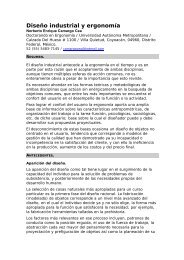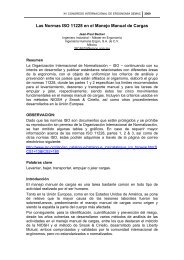ERGONOMÍA OCUPACIONAL - SOCIEDAD DE ERGONOMISTAS ...
ERGONOMÍA OCUPACIONAL - SOCIEDAD DE ERGONOMISTAS ...
ERGONOMÍA OCUPACIONAL - SOCIEDAD DE ERGONOMISTAS ...
Create successful ePaper yourself
Turn your PDF publications into a flip-book with our unique Google optimized e-Paper software.
Ergonomía Ocupacional. Investigaciones y Aplicaciones. Vol 3 2010<br />
Mexico, because it can be one of the causes of lower back pain , resulting from manual material<br />
handling, is a problem that is occurring more often in business. This led to pose the question "The<br />
maximum acceptable weight women, the tables set by Liberty Mutual, is applicable to workers in<br />
Caborca?<br />
3. MATERIALS AND METHODS<br />
Details of the experiment, from where the Liberty Mutual Tables were made, it is found in the<br />
publications of Ciriello et al 1983, 1990 and 1991. The experiment was conducted using<br />
psychophysical approach. This approach requires that the subject is motivated by an incentive,<br />
and He,based on the perceived sensations, select the maximum load that it considers may sustain<br />
for a working day of 8 hr. According to Shoaf (1997), the major hypothesis of the psychophysical<br />
approach is that: at a given time, adjusted to 40 minutes, a person is able to predict the maximum<br />
weight or force that could be manipulated during a period of 8 hr; Mital (1983) states, people can<br />
estimate the amount of weight that can lift comfortably in 8 hr, based on experiencing fatigue in 25<br />
min and, hopefully, the weight selected by the subject is the same whether the person continues<br />
lifting it for 8 hr; Additionally, he states: there is no literature evidence to validate this claim.<br />
Under these criteria, basically, the subject is given control of the weight of the load, the participant<br />
monitors their own sensations of fatigue and adjusts the weight which he believes could bear. All<br />
other variables such as task frequency, load weight, distance of movement, etc.. are controlled by<br />
the experimenter. The participants in this experiment were 14 young female between 19 and 22<br />
years, they were university-level students they could be part of the workforce in the Caborca<br />
region. All signed in writing that they were free of lower back injury and had no cardiovascular<br />
disease. They used casual clothing and tennis shoes, jeans and loose shirts.<br />
To all participant in the experiment and for verify that the heights and distances of<br />
movement of loads in lifting tasks was be according to the experiment of Snook, were taken the<br />
anthropometric measures of weight, height, knuckle height, acromial height and extended arm<br />
height. Given the limited experience of the participants in manual handling of loads were given a<br />
belt to help keep your lower back straight. The participants were given training equal to the<br />
training done it in Ciriello et al (1983) experiment, to familiarize them with the activities to<br />
performed and gain experience in adjusting the load, increase or decrease according to their own<br />
Sociedad de Ergonomistas de México, A.C. 49




